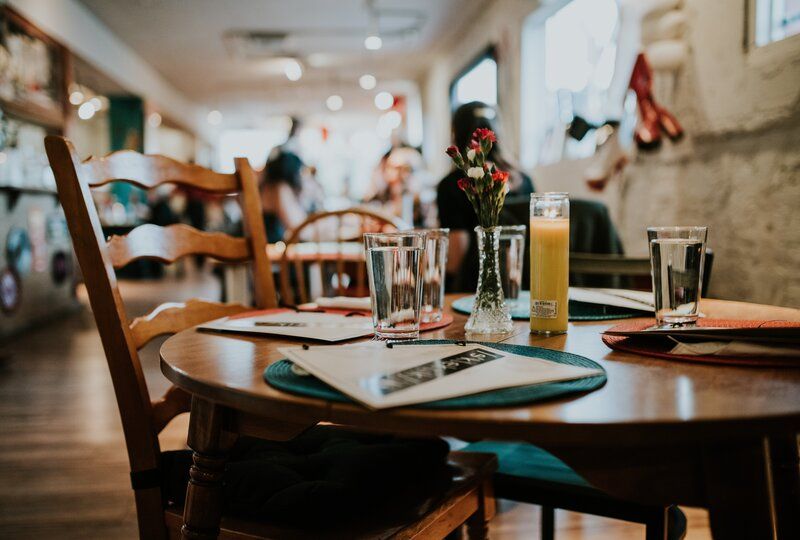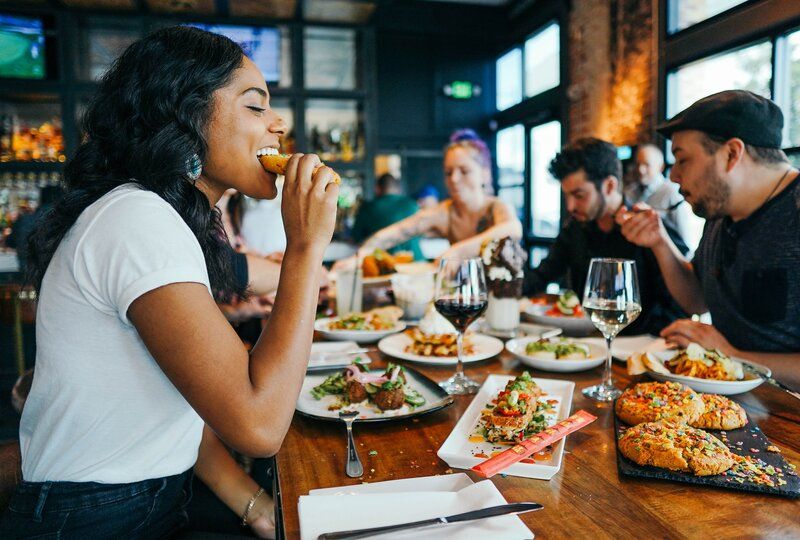How to Order at a Restaurant in English

Whether you love to patronize your local restaurant every night or you prefer to cook at home, knowing how to order food in English is an undeniably important skill for English language learnings.
Let's say you're traveling and trying to impress your friends--or even your boss! Or you could even be planning to spend a holiday working abroad and you need to know English service industry lingo. In all of these situations, familiarizing yourself with the intricacies of ordering and paying at a restaurant in English could save you from embarrassment--or worse, getting the wrong dish!
When in doubt, pointing at a picture to your waiter and saying "This, please" will work in a pinch, but there's so much more that you should know! In this article, we're going to explain some nuances of ordering in English, how to navigate more complicated situations, and some social norms you might find in restaurants in English-speaking countries.
Without further ado, read on so you can impress all of your friends with your effortless etiquette and English skills!

First Course: Learn the Basics
As Kelsey taught us, many words (and food names) are different in the English-speaking world, especially between the US and England!
The variety of English in different countries will come up later, but first, let's break down a a basic list of vocabulary that is very useful in any dining situation:
A party of (number of people) - a group of people who are dining together. In this context, it does not mean a celebration.
Booking/Reservation - when you arrange in advance with the restaurant to reserve your table at a specific time.
Bill/check - the printed receipt of what you owe for the food.
Ex. "Could we get the check, please?"
Cash - physical money, usually in the form of bills or coins.
Course - a set of food served during a meal.
Dessert - the smaller portion served after the main meal, usually sweet.
Dish - a particular variety or preparation of food.
Ex. "Tikka Masala is one of the most popular dishes in England."
Drink menu - a menu listing all the beverages, often alcoholic.
Gluten-free - food without gluten
Halal - food prepared according to Muslim law.
Kid's/Children's Menu - a menu for children. They are usually smaller portions and limited to those who are 12 years old or younger.
Kosher - food prepared according to Jewish law.
Main course/Entree - loaned from French, entree (or main course) means the main and most substantial portion of food served during the meal. Typically, this could be pasta, meat, or rice.
Meal - the food you eat, or the standard time of day when food is regularly eaten.
Ex. "The children's meal is the perfect size for a child." or "I normally eat my meals at the kitchen table."
Menu - a printed or digital list of what food the restaurant offers.
Napkin - thin paper, tissue or cloth that you use to clean your hands or mouth.
Organic - food that is grown without pesticides or other artificial farming methods.
Portion - the amount of food you are served.
Recommended - what the restaurant, chef or server believe to be the best or most popular dish.
Server/waiter/waitress - the person who takes your order and delivers your food. Waiter is used for men, and waitress is used for women, while server is gender neutral.
Set menu - a specific menu, usually involving one more courses, such as an appetizer, entree and dessert, for a fixed price.
Side dish - a smaller portion of food served during the meal, usually to complement the main dish.
Ex. "French Fries/Chips are a common side dish for a hamburger."
Silverware/Cutlery - the tools you use to eat your food, such as a knife, fork, or spoon.
Sparkling water - sometimes (but not always) called mineral water, this is water that is carbonated.
Starter/appetizer - the food you begin your meal with. It is usually a smaller portion and serves to ready your appetite.
Today's special/Special of the Day - the food that the restaurant is serving as a specialty, often only available on that day.
Tip - to give someone extra money as a reward for great service.
Tap water - also known as "still water", this is water that is not carbonated and usually comes straight from the tap.
Vegan option - a food option that contains no meat nor any animal products, like eggs or dairy.
Vegetarian option - a food option that contains no meat, but might contain other animal products, like eggs or dairy.
That's it! Check out this video to hear some of these words put into a practice conversation, in British English.
If you prefer American English, try this video using TV series as examples.

Second Course: Learn How to Order
Let's break down the steps of eating out at a restaurant.
English Phrases to Start Your Meal
Many places prefer if you call in advance to reserve a table, especially if you have a big party. (Remember, here, party means "a group," not a celebration.)
To place a reservation, you can say:
"Hello, I would like to make a booking/reservation for a party of (number of people) at (time) on (day)."
Ex. Hello, I'd like to make a booking for a party of 6 at 8 o'clock on Tuesday.
If you have no booking and walk into a restaurant, you can ask:
"Hello, do you have availability for a party of (number of people)?"
Or they might ask right away:
"How many people are in your party?" And you can answer with your group size.
As you sit down, you can ask for the main menu or for special menus like the children's menu or a drink menu. If your server comes by before you are ready, simply tell them:
"We need a few more minutes, please."
How to Order Food in English
Order in English usually looks like this:
"I'd like the (name of the dish), please."
Ex. "I'd like the fried rice with shrimp, please."
Here are more ways to order food, ranging from most formal to least formal.
- Could I have the (dish name), please? (polite)
- I'd like the.../I'll have the... (polite)
- The (dish name), please. (neutral)
- I want the (dish name). (informal)
- Give me the (dish name). (informal)
When ordering for others, we often use the same forms but with indications for who we are speaking for:
"For her/him/them, she/he/they'll have the..."
"We'll share the..."
It's also common to ask for suggestions. You can ask the server:
"What do you recommend?"
"What is the special for today?"
Your server might ask you follow-up questions, such as:
"How would you like your meat cooked?"
"How would you like your eggs cooked?"
Dietary Restrictions and Asking for Exceptions in English
If you have dietary restrictions--that is, specific needs for your food--you can ask your server.
Here are some examples of useful phrases for common dietary restrictions:
- "Does this food contain (meat/nuts/dairy)?
- "Is this food kosher?"
- "Can I have (ingredient you want) instead of (ingredient it has)?" or "Could I substitute the (ingredient it has) with (ingredient you want)?"
- Ex. Could I substitute the chips with a salad?
- "Is this dish vegetarian/vegan?"
- "I'm allergic to/I can't eat (ingredient), what dishes do you recommend for me?"
Ordering To-Go/Takeaway
While many places offer food delivery through apps, sometimes it is still cheaper to call a place directly and order! To order over the phone, it's the same as in person--however, you'll need to be prepared to give your address and phone number.
If you are stopping in a restaurant and would like to take your food home, simply tell them:
"To-go, please."
"For takeaway, please."
If you're eating out at a restaurant but don't finish your food and would like to take it home (perhaps useful in places like the US, where portions are HUGE!), here are some useful phrases:
Could I get a to-go box?
Can I have a doggy bag? (slang for a box for takeaway).
Helpful English Phrases for Miscellaneous Situations
Here's some quick tips on troubleshooting.
If you drop your silverware or it's dirty, you can ask:
"Could I have another (fork/knife/spoon), please?"
If your food arrives cold or off in some way, tell them:
"Excuse me, my food is (cold/undercooked/overcooked), could you send this back?"
Or, if they deliver you something you didn't order, you can say:
"Excuse me, I ordered something different, the (dish name)."
If the kitchen has run out of an ingredient, the server might tell you:
"I'm sorry, we are out of..." and then they will ask you to choose another dish.
Whew. Hopefully this doesn't happen! When in doubt, stick to this useful phrase:
"Could I have...(whatever you need)?"
Learn How to Ask for the Check
At last! You are full and hopefully had a great meal. Before you go, you must ask for the check.
The best way to ask is to simply say:
"I'd like the bill/check/to pay, please!"
Sometimes the waiter might ask you if you would like to pay together as a group, or separately. They might also ask if you prefer to pay with card or with cash.
Check your receipt and see if there has been a service charge already added. If not, read on below for more information on tipping and other social trends you might find in parts of the English-speaking world!

Social Nuances of Ordering in English-Speaking Countries
In many English-speaking countries, dining out has certain social expectations. For example, in the USA, your server is expected to be incredibly involved, polite, and prompt. If you are from a country that prefers a more relaxed dining style, such as Spain, you might be a little put off if your server immediately hands you the check without you first asking for it. (You can read more here for dining cultural differences in the US from the rest of the world.)
Or, for example, in some countries like South Korea, calling out your request from a distance is considered totally normal. However, in many English-speaking countries, this would be considered rude (it is considered more appropriate to make eye contact with your server, say "excuse me" and wait for them to come to you).
Customer service in the US is often a bit too cheerful for some. This is because in places like the US and Canada, servers are hoping to earn your favor. This brings me to...
Tips! Tips, as we explained above, are extra money you give to your server for their good service. In the US, this can be anywhere from 15-20% of your bill, with the higher percentage indicating you had great service. In Canada, this is more often 15%.
However, some casual or no-service based restaurants, like food trucks or fast casual places, might not require or expect a tip.
In Australia and New Zealand, it is not as common, and when it does occur, is more around 5%. The UK, however, has little to no tipping culture at all and is not expected.
If this seems confusing, don't worry! Do a bit of research on the dining differences of the regions you are interested in. Here's a guide to tipping around the globe. As you know, the Anglophone world is big and varied, and norms not only vary within, but are also constantly changing. Read here for more information on making the most of your study abroad--or work holiday or trip!

English Has Never Been so Easy!
To conclude, I've created a practice conversation that ties ALLLLL the information we've learned together.
Let's read this conversation between the server and Hannah, a native English speaker.
Server: Hello, welcome to Speechling's Incredible Restaurant! How many people are in your party?
Hannah: We are a party of seven. We have a reservation for 7:30 under the name 'Hannah'.
Server: Great! Follow me to your table.
Server: Here are your menus. Our special for today is mushroom risotto. I'll be back in a moment to take your order.
Server: What would you like to order?
Hannah: To drink, we'll have waters.
Server: Still or sparkling?
Hannah: Still, please.
Server: And to eat?
Hannah: To start, we'll share the truffle croquettes.
Server: Great, and for the main course?
Hannah: I'll have the eggplant parmesan with the salad. For her, she can't have nuts. Does the pesto pasta contain nuts?
Server: Yes, it contains pine nuts. I would recommend the marinara pasta instead.
Hannah: Great. And is that vegetarian?
Server: Yes!
Hannah: Perfect. Now, for him, he would like the garlic pizza. Is it possible to substitute the mushrooms for another vegetable?
Server: Sure, we can add eggplant or peppers.
Hannah: The peppers sound great. That's it!
Server: I'll be back soon with your order!
Server: Here's your food.
Hannah: Oh, this eggplant parmesan is a little cold.
Server: Would you like me to send it back?
Hannah: Yes, please.
Server: I'll be right back with a new plate of eggplant parmesan!
Hannah: Excuse me, we would like the check.
Server: Right away! Together or separate?
Hannah: Together, and with card.
Server: Here you are.
Hannah: I'm leaving a 20% tip because you were so wonderful!
Server: Thank you!
As you can see, this interaction uses much of the vocabulary and phrases we learned. You have probably noticed by now that most of ordering in English is sticking to set phrases that are easy to memorize. With a little practice and some time, you'll be ordering like a pro!
Now, you are totally prepared to order in front of all your family and friends. Go forth, and enjoy!
